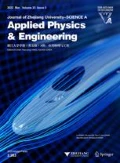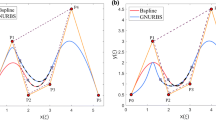Abstract
Curve and surface blending is an important operation in CAD systems, in which a non-uniform rational B-spline (NURBS) has been used as the de facto standard. In local corner blending, two curves intersecting at that corner are first made disjoint, and then the third blending curve is added-in to smoothly join the two curves with G1-or G2-continuity. In this paper we present a study to solve the joint problem based on curve extension. The following nice properties of this extension algorithm are exploited in depth: (1) The parameterization of the original shapes does not change; (2) No additional fragments are created. Various examples are presented to demonstrate that our solution is simple and efficient.
Similar content being viewed by others
References
Hu, S.M., Tai, C.L., Zhang, S., 2002. An extension algorithm for B-splines by curve unclamping. Computer-Aided Design, 34(5):415–419. [doi:10.1016/S0010-4485(01)00108-7]
Mo, G.L., Zhao, Y.N., 2006. A new extension algorithm for cubic B-splines based on minimal strain energy. J. Zhejiang Univ. Sci. A, 7(12):2043–2049. [doi:10.1631/jzus.2006.A2043]
Piegl, L., Tiller, W., 1997. The NURBS Book. Springer-Verlag, New York, NY.
Poeschl, T., 1984. Detecting surface irregularities using isophotes. Computer Aided Geometric Design, 1(2):163–168. [doi:10.1016/0167-8396(84)90028-1]
Press, W., Teukolsky, S., Vetterling, W., Flannery, B., 2002. Numerical Recipes in C++ (2nd Ed.). Cambridge University Press, Cambridge, UK.
Vida, J., Martin, R.R., Varady, T., 1994. A survey of blending methods that use parametric surfaces. Computer-Aided Design, 26(5):341–365. [doi:10.1016/0010-4485(94)90023-X]
Wallner, J., 2007. Note on curve and surface energies. Computer Aided Geometric Design, 24(8–9):494–498. [doi:10.1016/j.cagd.2007.05.007]
Wang, J., Wang, G., Zheng, J., 2001. Computer Aided Geometric Design. China Higher Education Press, Beijing, China (in Chinese).
Zang, Y., Liu, Y., Lai, Y., 2008. Note on industrial applications of Hu’s surface extension algorithm. LNCS, 4975:304–314.
Author information
Authors and Affiliations
Corresponding author
Additional information
Project supported by the National Natural Science Foundation of China (Nos. 60603085 and 60736019), the Hi-Tech Research and Development (863) Program of China (No. 2007AA01Z336), and Tsinghua Basic Research Foundation, China
Expanded based on “Note on industrial applications of Hu’s surface extension algorithm” by Yu Zang, Yong-Jin Liu, et al., which appeared in GMP2008, LNCS, 4975:304–314
Rights and permissions
About this article
Cite this article
Liu, Yj., Qiu, Rq. & Liang, Xh. NURBS curve blending using extension. J. Zhejiang Univ. Sci. A 10, 570–576 (2009). https://doi.org/10.1631/jzus.A0820819
Received:
Accepted:
Published:
Issue Date:
DOI: https://doi.org/10.1631/jzus.A0820819




